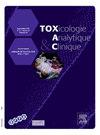Quantitation using high-resolution mass spectrometry (HRMS)
IF 1.8
Q4 TOXICOLOGY
引用次数: 0
Abstract
Objective
To provide an overview of the technical differences between triple quadrupole (QQQ), quadrupole-time of flight (QTOF) and orbitrap mass spectrometers, then to provide a commentary on the quantitative performance of each instrument type, with examples from the author's own laboratory.
Discussion
QQQ instruments are primarily used in multiple reaction monitoring (MRM) mode in a targeted fashion, meaning compounds are only detected if pre-programmed in the acquisition method. QTOF and orbitrap instruments are commonly used in full scan mode and therefore capture a far larger amount of information, with all ionisable compounds capable of being detected, whether they are targeted or not.
QTOF spectra are typically composed of hundreds to thousands of individual ion packets, termed transients. The sensitivity of a QTOF method can be increased by summing a greater number of transients at the expense of scan speed. Orbitrap instruments are not affected by this but the resolution increases as a transient spends a longer time in the orbitrap, which reduces the scan speed.
In an orbitrap instrument, ions are first accumulated in the C-trap before being injected into the orbitrap analyser. To prevent overfilling of the orbitrap, the number of ions injected is controlled at this step. The resulting spectrum is then mathematically adjusted using automatic gain control (AGC) to maintain the quantitative accuracy of the data. AGC can improve the overall dynamic range across different spectra, but it may restrict the simultaneous measurement of very abundant and trace compounds within a single spectrum compared to QTOF instruments.
All three instrument designs commonly offer excellent precision, but modern QQQ instruments may provide superior sensitivity. The aspects of selectivity most relevant to quantitation are the amount of noise, and the frequency and abundance of interfering peaks from the matrix. It has been the experience of Forensic Science SA that extracted ion chromatograms from LC-QTOF data using appropriately narrow mass extraction windows usually show less noise and fewer interfering matrix peaks than MRM data from LC-QQQ methods.
Ease of use is subjective and can often be influenced by the experience of a person or the laboratory. Although HRMS instruments still have a reputation as being difficult to set up and use, at Forensic Science SA, most if not all scientists would consider it easier to set up a quantitative method using an LC-QTOF instrument, than determine and optimise MRMs on an LC-QQQ. Troubleshooting mass spectral issues that can affect quantitative results including co-eluting analyte suppression and formation of adducts, dimers and multiply charged ions is much simpler using full scan HRMS data.
Conclusion
High-resolution mass spectrometers demonstrate excellent quantitative capabilities in addition to their established screening advantages. While modern high-end QQQ instruments generally offer superior sensitivity and potentially wider linear dynamic ranges than current HRMS instruments, HRMS instruments provide comparable precision and often superior selectivity. Although some specific analyses may benefit from QQQ analysis, HRMS instruments prove suitable for most quantitative applications in forensic toxicology.
高分辨率质谱(HRMS)定量
目的概述三重四极杆质谱仪(QQQ)、四极杆飞行时间质谱仪(QTOF)和轨道阱质谱仪之间的技术差异,并结合自己实验室的实例,对每种仪器的定量性能进行评述。qqq仪器主要用于有针对性的多反应监测(MRM)模式,这意味着只有在获取方法中预先编程才能检测到化合物。QTOF和orbitrap仪器通常在全扫描模式下使用,因此捕获的信息量要大得多,所有可电离化合物都能被检测到,无论它们是否是目标化合物。QTOF光谱通常由数百到数千个单独的离子包组成,称为瞬态。以牺牲扫描速度为代价,对更多的瞬态求和可以提高QTOF方法的灵敏度。Orbitrap仪器不受此影响,但随着瞬态在Orbitrap中停留时间的延长,分辨率会增加,这降低了扫描速度。在轨道阱仪器中,离子首先在c阱中积累,然后注入轨道阱分析仪。为了防止轨道阱过度填充,在这一步骤中控制注入离子的数量。然后使用自动增益控制(AGC)对所得频谱进行数学调整,以保持数据的定量准确性。AGC可以提高不同光谱的整体动态范围,但与QTOF仪器相比,它可能会限制在单个光谱内同时测量非常丰富和痕量化合物。所有这三种仪器设计通常都提供出色的精度,但现代QQQ仪器可能提供更高的灵敏度。与定量最相关的选择性方面是噪声的量,以及来自矩阵的干扰峰的频率和丰度。根据法医科学SA的经验,使用适当窄的质量提取窗口从LC-QTOF数据中提取离子色谱,通常比LC-QQQ方法的MRM数据显示更少的噪声和更少的干扰矩阵峰。易用性是主观的,通常会受到个人或实验室经验的影响。虽然HRMS仪器仍然以难以设置和使用而闻名,但在法医科学SA,大多数(如果不是所有)科学家会认为使用LC-QTOF仪器建立定量方法比在LC-QQQ上确定和优化MRMs更容易。使用全扫描HRMS数据,可以更简单地排除可能影响定量结果的质谱问题,包括共洗脱分析物抑制和加合物、二聚体和多电荷离子的形成。结论高分辨率质谱除了具有既定的筛选优势外,还具有良好的定量能力。虽然现代高端QQQ仪器通常比目前的HRMS仪器具有更高的灵敏度和更宽的线性动态范围,但HRMS仪器具有相当的精度和更高的选择性。虽然QQQ分析可能对某些特定的分析有益,但HRMS仪器被证明适用于法医毒理学的大多数定量应用。
本文章由计算机程序翻译,如有差异,请以英文原文为准。
求助全文
约1分钟内获得全文
求助全文

 求助内容:
求助内容: 应助结果提醒方式:
应助结果提醒方式:


